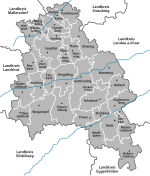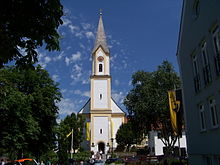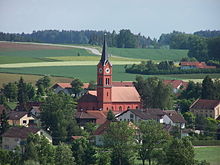Mengkofen
| coat of arms | Germany map | |
|---|---|---|

|
Coordinates: 48 ° 43 ' N , 12 ° 26' E |
|
| Basic data | ||
| State : | Bavaria | |
| Administrative region : | Lower Bavaria | |
| County : | Dingolfing-Landau | |
| Height : | 398 m above sea level NHN | |
| Area : | 84.75 km 2 | |
| Residents: | 6035 (Dec. 31, 2019) | |
| Population density : | 71 inhabitants per km 2 | |
| Postcodes : | 84152, 84150 | |
| Primaries : | 08733, 08774, 09427 | |
| License plate : | DGF, LAN | |
| Community key : | 09 2 79 127 | |
| Community structure: | 110 parts of the municipality 5 districts |
|
| Address of the municipal administration: |
Von-Haniel-Allee 12 84152, 84150 Mengkofen |
|
| Website : | ||
| Mayor : | Thomas Hieninger ( CSU ) | |
| Location of the community Mengkofen in the district of Dingolfing-Landau | ||
Mengkofen is a municipality in the Lower Bavarian district of Dingolfing-Landau .
geography
location
Mengkofen is located in the Aitrach valley , which is part of the tertiary hill country .
Community structure
In addition to the main town and parish village Mengkofen, the 110 parish parts of Mengkofen also include the other parish villages Hofdorf , Martinsbuch , Obertunding and Steinbach as well as the church villages Dengkofen , Hagenau , Hüttenkofen , Ottending , Pramersbuch, Puchhausen , Tunzenberg and Weichshofen . Mengkofen also includes the villages of Ettenkofen , Hönigsbach, Kirchlehen, Klein Weichshofen, Krottenthal, Leppersberg, Mühlhausen , Niedertunding, Oberwackerstall, Pramwinkl, Radlkofen, Schönrain, Süßkofen , Vogelsang, Weitenhülln and Ziegelstadel, the hamlets of Birket, Bräugraben, Eckhof Ginhart , Haberdorn, Hammelhof, Hausenthal, Hochstraß, Hueb, Kleinhaslau, Kothlacken, Lueg, Multham, Obersteinbach, Rasch, Rogau, Unterneiger, Untersalhof, Unterwackerstall, Wackerstall and Wunder as well as the desert areas ( individual settlements ) Altendorf, Auholz, Berg, Brettbach, Bruckhof , Brunnholz, Buchwald, Eck, Eisental, Esterthal, Frauenthal, Furth, Großlug, Grünleiten, Hanny , Haunhart, Haunmühle, Haunsdorf, Heinzleck, Hinflucht, Hofstetten, Huchelwies, Hüttleiten, Klausen, Kleinlug, Kohlschlag, Kupfermühl, Limbach, Lohe, Mauka , Meising, Misslbach, Muckenwinkel, Murrenkreuth, Neukreit, Neukreut, Niederreuth, Oberallmannsbach, Oberbibelsbach, Oberhirschwell, Oberhütt, Oberreuth, Obersalhof, Pfarrholz, Raschen, Rauheck, Rauhleiten, Reifberg, Reith, Rumplmühl, Sommeracker, Steinbühl, Stolzenberg, Süßwies, Unterallmannsbach, Unterhirschwell, Unterhütt and Waldhof.
Markings
The five districts are Hofdorf, Hüttenkofen, Martinsbuch, Mühlhausen and Tunzenberg.
history
timeline
- In the first half of the 12th century, Mengkofen is known to have a larger manor. First of all was a Babo von Mengkofen.
- 1140/27/1, the consecration of the St. Wolfsgangkapelle inprüfunging is documented in a document. It was built as a family burial place. Erchinbert von Stirn (later the Altendorf and Leonsberg family, leaving 1329), Wernher von Mengkofen and Babo von Zulling (near Landau, leaving around 1200) are mentioned.
- Wernher von Mengkofen went on the second crusade in 1147 (last mentioned). He was a swordtail (miles) of the Counts of Sulzbach. With his death, the property was split up (Stirn / Zulling / Abensberg). With heir daughter Sophie, the wife of Count Gebhard von Abensberg , the property in Mengkofen went to the Abensbergers. At Mengkofen there were now the Count's ministerials , who called themselves soon after.
- December 19, 1253: The name Mengkofen (also: Menchofer, Maeinhover, Mengkofer) appears for the first time in a peace treaty between Bishop Albert of Regensburg and the dukes Ludwig and Heinrich of Bavaria as arbitrator. Berthold the Maeinchover , who, together with his daughter Margarethe, wife of Ulrich von Teisbach, was mentioned in a Teisbach court document of February 26, 1296.
- Ulrich der Menchofer zu Choelnpach (today Großköllnbach ) appears as a court assessor in a court document from Leonsberg in 1378, as Taidinger in a court document from Landshut from 1396 and contractor in a deed of assignment of goods from 1409.
- As the keeper of Erding, a Dingolfing court document from 1335 names Chunrat den Memchofaer as judge from Leonsberg 1378 a Leonsberg court document Hans den Menchover.
- The large handwritten coat of arms of the ducal Bavarian archivist Lieb, which was created around 1600 to 1609, mentions the aforementioned Hans the Mechover with the addition of "zu Salach" for the year 1358, and Erhard Menkhofer for 1411 "Pfleger am Frauenhaus" in the "Baierischen" War (ie in the Bavarian-Palatinate War of Succession of 1504/1505). This Mengkofer seems to have been the last of his tribe. Since 1570 other owners of the formerly large Mengkofen estates have been documented, who were probably not descendants of the family by blood.
- As a symbol of the oldest local rule, the coat of arms with the bear's paw symbolizes a large piece of local history. The shape of the heraldic shield and the representation of the heraldic figure are based on the oldest models in the seal impressions from the years 1335 and 1378.
- May 4, 1939, after completing a few formalities, a document signed by Franz von Epp personally arrived , with an enclosed coat of arms showing a black, curved, red-armored bear paw on a gold background. This gave the municipality of Mengkofen the right to use its own coat of arms.
Incorporations
Weichshofen, located immediately southwest of Mengkofen, was incorporated into Mengkofen on January 1, 1946 by order of the local department of the US military government. However, this incorporation was reversed by the Bavarian Ministry of the Interior between 1947 and 1949. The final incorporation took place on January 1, 1971 in the course of the regional reform in Bavaria . On January 1 and July 1, 1972, more parishes were added. On May 1, 1978, the series of incorporations was completed with the incorporation of Hüttenkofen, Mühlhausen (formerly in the Mallersdorf district ) and Süßkofen (also previously in the Mallersdorf district; with the parts of the former municipality of Asbach incorporated on January 1, 1970).

| local community | District | Area ha |
Residents (1970) |
Incorporation date |
|---|---|---|---|---|
| Hofdorf | Hofdorf | 968.91 | 357 | 01/01/1972 |
| Hüttenkofen | Hüttenkofen | 697.98 | 287 | 05/01/1978 |
| Martin's book | Martin's book | 1093.03 | 448 | 07/01/1972 |
| Mulhouse | Mulhouse | 656.09 | 281 | 05/01/1978 |
| Puchhausen | Hüttenkofen | 1181.92 | 463 | 01/01/1972 |
| Sweet oven | Mulhouse | 1345.86 | 545 | 05/01/1978 |
| Tunding | Tunzenberg | 574.82 | 331 | 01/01/1971 |
| Tunzenberg | Tunzenberg | 924.86 | 328 | 01/01/1971 |
| Weichshofen | Hofdorf | 317.07 | 335 | 01/01/1971 |
Population development
In the period from 1988 to 2018, the municipality grew from 4,387 to 6,114 by 1,727 inhabitants or 39.4%.
politics
Municipal council
In the period 2020 to 2026, the Mengkofen town council has 20 members, plus the first mayor.
| CSU | SPD / active citizens | Aitrachtaler Citizens List / Free Voters | Tundinger Citizen List | For the Aitrachtaler | total | |
| 2002 | 9 | 4th | 7th | 20 seats | ||
| 2008 | 7th | 5 | 6th | 2 | 20 seats | |
| 2014 | 6th | 6th | 6th | 2 | 20 seats | |
| 2020 | 6th | 5 | 4th | 2 | 3 | 20 seats |
mayor
The first mayor is Thomas Hieninger (CSU); he was elected on March 15, 2020 with 52.7% of the vote and took office on May 1, 2020. In 2008 Karl Maier (Aitrachtaler Bürgerliste / Free Voters) was elected mayor and was confirmed in office in 2014 without an opposing candidate. For several years he was the second mayor under his predecessor Josef Forster (CSU). In the municipal election in 2020 , he has not raced for more.
Josef Koch (SPD / Active Citizens) has been the second mayor since 2008 (re-elected in 2014 and 2020).
coat of arms
The description of the coat of arms reads: "In gold, a red armored black bear paw."
The municipal coat of arms corresponds to the ancestral coat of arms of the wealthy local noble family of Mengkofers, who were in the service of the Wittelsbachers. The coat of arms has been documented on seals since the beginning of the 14th century.
The coat of arms was awarded by decree of the Reich governor in Bavaria on March 4, 1939.
Legend has it that the coat of arms comes from Sigfridus the Menníchhofer. He is said to have had a fight with a bear on his way to Mengkofen. That is why the claws of the bear paw are also shown in red.
Attractions
- The Catholic branch church of the Assumption in Hüttenkofen. The new longhouse in bare brick from 1852 was designed by the architect Leonhard Schmidtner .
- Church of St. Georg in Weichshofen from 1886 (this church is mainly used because it is the largest)
- Church of the Annunciation in Mengkofen from 1722.
There is a story about this church:
The first church was in the "drendan village", which means on the other side of the Aiterach , a larger stream that flows to the Danube . To get to the church from the castle, you had to cross the Aiterach. When the Lerchenfeld couple drove back from church one day, there was a terrible storm and the stream had swelled into a river. As they drove on the old wooden bridge, it collapsed and with it the carriage. When they were swept away by the floods, Franz-Adam von Lerchenfeld said: If we get out of here alive, I'll build a new, larger church on the other side of the village. As if by a miracle, the horses pulled the carriage out of the water. Franz-Adam von Lerchenfeld kept his promise and built the church .
It is believed that the two figures on the high altar have the facial features of their builders. Left Franz-Adam von Lerchenfeld as Saint Francis von Sales and right his wife Margarethe von Lerchenfeld as Saint Margarethe . In the middle of the altar, on the tabernacle, is a figure. It shows a pelican sacrificing itself for its young. This should represent that Jesus sacrificed himself for us. The picture on the high altar shows the angel Gabriel's proclamation to Mary that she would bring a child into the world. This altarpiece was only made in the second half of the 20th century. Some photos of the previous painting have survived. St. Nicholas of Tolentino is depicted on the left side altar . Five stone slabs are built into the church. Behind most (four) people are likely to be buried. The builder of the church himself, namely Franz Adam Joseph von Lerchenfeld, is buried on the right edge of the church.
- Mengkofen Castle, from 1951 the monastery of the Sisters of Mercy of the Holy Cross, previously refugee accommodation. It serves as a retirement home for the order. In the east wing there is a kindergarten under their sponsorship. The newest building of the monastery, which extends south along the Bräugraben into the gardens, is now used, together with the secular Kreuzkapelle, of a specialist clinic for rehabilitation. The three-storey main building of the relatively spacious palace complex with corner towers and stepped gables was rebuilt in 1842 after a fire. The old castle was bigger, had its own church and much more.
Architectural monuments
age structure
| Age | total | Male | Female |
|---|---|---|---|
| 80 years and older | 318 | 106 | 212 |
| 66 to 79 years | 675 | 333 | 342 |
| 60 to 65 years | 436 | 247 | 189 |
| 50 to 59 years | 1184 | 637 | 547 |
| 40 to 49 years | 873 | 470 | 403 |
| 30 to 39 years | 950 | 552 | 398 |
| 19 to 29 years | 966 | 552 | 398 |
| 16 to 18 years | 178 | 91 | 87 |
| 7 to 15 years | 479 | 216 | 263 |
| 4 to 6 years | 168 | 82 | 86 |
| 0 to 3 years | 225 | 112 | 113 |
| Total: | 6452 | 3379 | 3073 |
This table shows the population of the main and secondary residences.
The number of residents with main residence is 6158.
As of November 13, 2017
literature
- Michael Sirl: The three court brands Mengkofen, Weichshofen, Tunzenberg, District Office Dingolfing, District of Lower Bavaria: a local history. Kaufbeuren 1917.
- Franz Tyroller: The Lords and Counts of Altendorf and Leonberg. In: ZBLG. 14 1943/44, pp. 63-127.
Individual evidence
- ↑ "Data 2" sheet, Statistical Report A1200C 202041 Population of the municipalities, districts and administrative districts 1st quarter 2020 (population based on the 2011 census) ( help ).
- ^ Mengkofen community in the local database of the Bavarian State Library Online . Bayerische Staatsbibliothek, accessed on February 22, 2018.
- ↑ a b c d e f g Wilhelm Volkert (Ed.): Handbook of the Bavarian offices, municipalities and courts 1799–1980 . CH Beck, Munich 1983, ISBN 3-406-09669-7 , p. 447 .
- ↑ a b c d Federal Statistical Office (Hrsg.): Historical municipality register for the Federal Republic of Germany. Name, border and key number changes in municipalities, counties and administrative districts from May 27, 1970 to December 31, 1982 . W. Kohlhammer, Stuttgart / Mainz 1983, ISBN 3-17-003263-1 , p. 634 .
- ↑ Allocation of seats to the parliamentary groups
- ^ Mengkofen community (ed.): Citizen's letter of the Mengkofen community . 2017, p. 10 .
Web links
- Entry on the Mengkofen coat of arms in the database of the House of Bavarian History
- Official homepage of the municipality
- Mengkofen: Official statistics of the LfStat (PDF; 1.66 MB)






